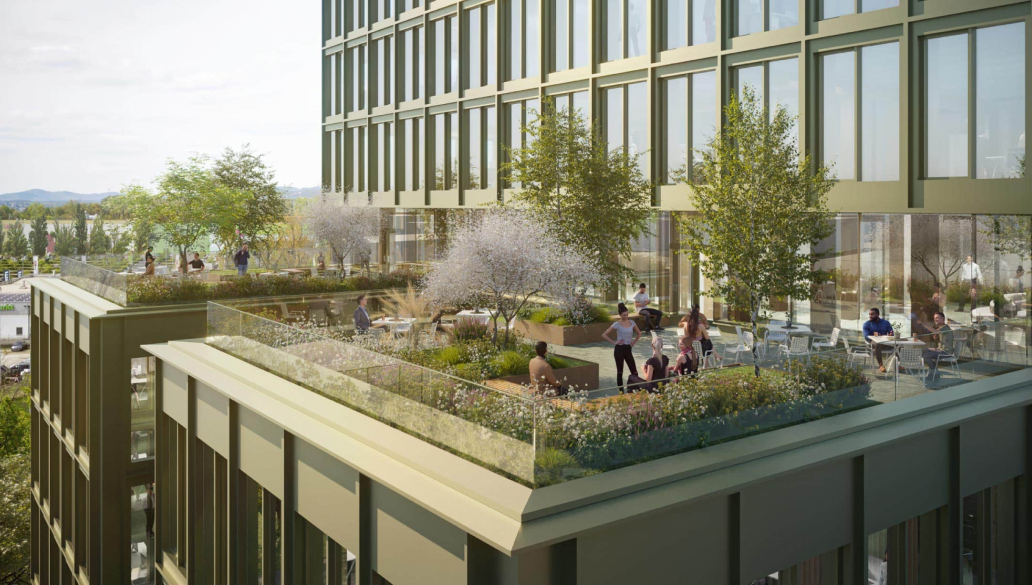Facts
Location
Eschborn, Germany
Nemetschek Group Brands
Vectorworks
Technology used
Vectorworks Architect
Solibri
grabowski.spork architektur is spearheading the development of “The Change,” the first timber-hybrid high-rise office building in Eschborn, in collaboration with Bauwens & Ampure. This groundbreaking 15-story office tower will offer approximately 13,500 square meters of customizable rental space designed to enhance the overall quality of the work environment.
grabowski.spork architektur
In line with our commitment to excellence in architecture, we are dedicated to delivering a sustainable solution that integrates the innovative BIM planning method seamlessly with our project team.
Innovation in Sustainable Design
The architectural firm values the innovative use of materials, showcasing a diverse range of options. This project seamlessly integrates wood and concrete to create a hybrid superstructure. Concrete is predominantly used for the building foundation and access core, while on the upper floors wood replaces concrete for its structural qualities and to reduce the building’s carbon footprint. This combination not only benefits the environment but also enhances the interior, creating a welcoming and comfortable working environment.
With this project, the team aims at achieving the prestigious DGNB platinum certification. To achieve this goal, the design team incorporated sustainable technologies. A significant portion of the building energy supply will be sourced from a geothermal solar photovoltaic system. The building will also have charging stations for electric vehicles. Smart water management systems, including a cistern for rainwater harvesting, provide an innovative solution to reduce overall water consumption. The existing trees will be preserved and complemented by diverse plantings, while greenery adorns the roof areas, enhancing the microclimate and biodiversity.
Planning an Efficient BIM Process
The intricate planning and thorough technical coordination for "The Change" were carried out using Vectorworks Architect. Leveraging the benefits of BIM workflows — such as precision, consistency, transparency, and material waste reduction — was crucial. The close collaboration among all team members resulted in a highly efficient BIM process. Initially, a BIM Execution Plan (BEP) and Project Information Requirements (PIR) were developed through workshops involving all stakeholders. The BEP outlined the project's specific organizational structures as defined by the PIR, while the PIR established project goals, objectives, and responsibilities. Working closely with the client’s BIM coordination team allowed grabowski.spork architektur to align the project’s BIM goals with the entire design team.
Inside the BIM Process
As established during the planning and BEP, the entire design team and the client’s BIM management team met on a bi-weekly basis to coordinate BIM models. Under the guidance of grabowski.spork architektur, in partnership with Build Effects GmbH, each discipline’s models were seamlessly integrated into a federated model to perform a clash detection report prior to each meeting. Clashes were reviewed and assessed at each meeting, and BCF issues were created and assigned to the corresponding discipline by the BIM manager using BIM collab as the BIM collaboration issue management platform. Following these meetings, each discipline was able to make appropriate changes to the model and resolve the BCF issues in BIM collab, keeping the entire team up to date at all times during the design process. In addition to the official BIM coordination meetings with the project's BIM manager, the design team held a weekly BIM coordination meeting, which allowed them to uphold architectural excellence and elevate the overall design quality.
Praising BIM with Vectorworks
“For us, 'The Change' was the first project set up for a full BIM collaboration process across all design disciplines. We learned a lot during the process and were able to gain valuable insights for our future projects,” the architects said. “After a successful preliminary construction request in August 2023, we can also say that the additional effort was worth it in every respect. The quick adaptation with an unfamiliar process and the intensive, interdisciplinary teamwork on the digital twin were ideal for getting started in developing routines for the complex workflow, but also for working together.”

